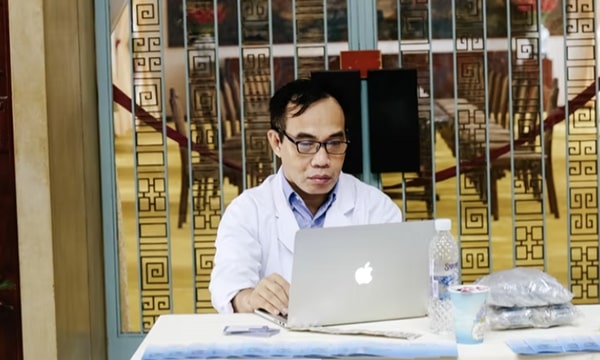 What does the future of healthcare look like post-pandemic? Since the tail end of 2019, all corners of the world have had to push the gas pedal and make healthcare innovation a global focus. Worldwide, we’ve seen and actively been a part of lightning-fast advancements in healthcare technology, not only in how it’s used but also in how it’s been reimagined.
What does the future of healthcare look like post-pandemic? Since the tail end of 2019, all corners of the world have had to push the gas pedal and make healthcare innovation a global focus. Worldwide, we’ve seen and actively been a part of lightning-fast advancements in healthcare technology, not only in how it’s used but also in how it’s been reimagined.
After having segued into a “new normal,” and experienced “unprecedented times,” we are now living in an exponentially more digital age where everything has become automated, digitized, integrated, and delivered right into your home. So what’s next for healthcare?
Hybrid Healthcare Models That Combine Technology And In-Person Visits
Virtual health became a critical necessity. Providing care online not only kept people safe during quarantine and isolation but also provided convenience and accessibility. Whether someone is in a dense city or far away in a rural location, patients were given direct access to the care and specialists they needed when in-person visits weren’t available. Since then, virtual visits and telehealth have revolutionized how people access care.
Now, with a focus on virtual and in-person hybrid models, “click and mortar” options combine the best features of in-person and virtual care to create better and more efficient outcomes for patients. Brick and mortar clinical visits will always be an option, however, with a shift towards the “click and mortar” model, it’s expected we’ll encounter more prescriptions being filled online, as well as follow-ups, diagnoses, and evaluations, and more.
Homecare Reimagined
Being able to stay at home to see the doctor instead of traveling has the capacity to greatly transform the quality of care, and accessibility as well as impact patient relations.
Firstly, patients don’t have to commute. Not only does this save time, money, and hassles, but patients can now choose their doctor, specialist, or healthcare practitioner based on experience instead of the location. The range of options just got a whole lot bigger for those who need very specialized care.
Furthermore, patients have the comfort and privacy of being in their own homes. Especially for extra sensitive matters, this could provide them the safety to open up and be more transparent during their visit. This works exceptionally well for support groups, and therapy sessions too.
Plus patients don’t have to schedule their days around their appointment. Scheduling and canceling become easier when it’s automated, and invitations and reminders are sent out the day of and the days leading up to the appointment. Fewer missed appointments mean fewer headaches and money saved.
Accelerating The Onset Of Artificial Intelligence
Automation and artificial intelligence are at the core of making the healthcare system more effective and efficient. By removing redundancies and tasks that are better suited to be carried out by AI instead of humans, both money and time are freed up to be spent elsewhere. Tasks like remote patient monitoring, EMRs, transcriptions, online meeting recordings, and other administrative duties can be cut down and done by AI.
Furthermore, AI-enabled algorithms can be designed to provide data and automated messaging. Virtual care enabled by sensors, devices, and diagnostic technology can measure a patient’s vitals and then send this information to remote doctors for an instant check-in. These tools allow doctors to quickly and proactively focus on a patient’s needs accurately.
Also, with an AI-enabled sentiment analysis feature, doctors and clinicians can gain valuable insights from meeting recordings. After recording and transcribing meetings, the sentiment analysis tool indicates emotional sentences and remarks as well as the tone of voice. Clinicians can use this tool to help get a feel for how a patient is feeling in order to improve and adjust care and patient relations.
Enhanced EMR APIs
Perhaps one of the trends that has the most potential is enhancing how EMR software is brought into the next phase of accelerated healthcare. A one-stop shop that automates and integrates digital information, and makes it easily digestible and accessible is the way of the future.
 According to McKinsey & Company, “More than ever before, patients and providers are relying on telehealth solutions to facilitate their communication and care. Up to $250 billion of current US healthcare spend could potentially be virtualized.”
According to McKinsey & Company, “More than ever before, patients and providers are relying on telehealth solutions to facilitate their communication and care. Up to $250 billion of current US healthcare spend could potentially be virtualized.”
With this growing surge and focus on telehealth, tools that can keep up with the demands of patients and care are required. Technology that automates anticipates, and provides feedback is how things will have to get done to keep up and maintain a high-level cycle of care. iotum provides your practice with:
- Appointment Management and Scheduling
Brings in email, calendar, SMS invitations, and reminders to save time and money with fewer missed appointments. - Remote HIPAA Compliant Conferencing API with Embedded Meeting SDK
Using download-free, high-quality video conferencing built right into your EMR software, access to care is fast and efficient, and wait time is significantly cut down. - Virtual Care Analytics API
Improve compliance and patient relations with a more in-depth look at how communication is being shared between patients and healthcare workers. Furthermore, by gauging emotional temperature via AI-Sentiment Analysis, not only is patient care enhanced, employees and workers can feel more comfortable sharing what they really want and need in the workplace.
With iotum, you can accelerate the level of communication within your practice, clinic, and hospital by improving and modernizing the ways you communicate internally and externally. Forecasted directions that healthcare is headed in like hybrid healthcare models, a focus on in-home care, AI, and improved EMRs are already here, if not here to stay. Future-proof your business with an all-in-one solution ready to perform when you are.
Learn more here.


